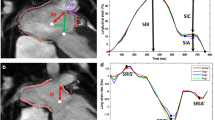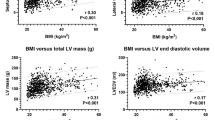Abstract
Although obesity is linked to heart failure on a population level, not all obese subjects develop cardiac failure. As a result, identifying obese subjects with subclinical changes in myocardial velocities may enable earlier detection of those susceptible to developing overt heart failure. As echocardiography is limited in obesity due to limited acoustic window, we used phase contrast magnetic resonance imaging to assess myocardial velocities in obese and normal weight subjects. Normal weight (BMI 23 ± 3; n = 40) and obese subjects (BMI 37 ± 7; n = 59) without identifiable cardiovascular risk factors underwent MRI (1.5 Tesla) to determine left ventricular myocardial velocities using phase contrast tissue phase mapping. Systolic function was not different between normal and obese subjects (LVEF 67 ± 5 vs 68 ± 4, p = 0.22). However, obesity was associated with significantly impaired peak radial and longitudinal diastolic myocardial velocity (by 13 and 19 % respectively, both p < 0.001). In addition time-to-peak longitudinal diastolic velocity was delayed in obesity (by 39 ms, p < 0.001). In addition, peak longitudinal diastolic strain was 20 % lower in obesity (p = 0.015) and time-to-peak longitudinal diastolic strain rate significantly delayed in obesity (by 92 ms, p < 0.001).Although peak radial systolic velocity was similar between obese and normal weight subjects (p = 0.14) peak longitudinal systolic velocity was 7 % lower in the obese cohort (p = 0.02). In obesity without co-morbidities, tissue phase mapping has shown subclinical changes in systolic and diastolic function. Given the link between obesity and heart failure, early detection of changes may become clinically important to prevent disease progression.



Similar content being viewed by others
References
Adams KF, Schatzkin A, Harris TB, Kipnis V, Mouw T, Ballard-Barbash R, Hollenbeck A, Leitzmann MF (2006) Overweight, obesity, and mortality in a large prospective cohort of persons 50 to 71 years old. N Engl J Med 355(8):763–778
Alpert MA (2001) Obesity cardiomyopathy: pathophysiology and evolution of the clinical syndrome. Am J Med Sci 321(4):225–236
Sutton-Tyrrell K, Newman A, Simonsick EM, Havlik R, Pahor M, Lakatta E, Spurgeon H, Vaitkevicius P (2001) Aortic stiffness is associated with visceral adiposity in older adults enrolled in the study of health, aging, and body composition. Hypertension 38(3):429–433
Kenchaiah S, Evans JC, Levy D, Wilson PW, Benjamin EJ, Larson MG, Kannel WB, Vasan RS (2002) Obesity and the risk of heart failure. N Engl J Med 347(5):305–313
Powell BD, Redfield MM, Bybee KA, Freeman WK, Rihal CS (2006) Association of obesity with left ventricular remodeling and diastolic dysfunction in patients without coronary artery disease. Am J Cardiol 98(1):116–120. doi:10.1016/j.amjcard.2006.01.063
Wong CY, O’Moore-Sullivan T, Leano R, Byrne N, Beller E, Marwick TH (2004) Alterations of left ventricular myocardial characteristics associated with obesity. Circulation 110(19):3081–3087
Scaglione R, Dichiara MA, Indovina A, Lipari R, Ganguzza A, Parrinello G, Capuana G, Merlino G, Licata G (1992) Left ventricular diastolic and systolic function in normotensive obese subjects: influence of degree and duration of obesity. Eur Heart J 13(6):738–742
Otto ME, Belohlavek M, Khandheria B, Gilman G, Svatikova A, Somers V (2004) Comparison of right and left ventricular function in obese and nonobese men. Am J Cardiol 93(12):1569–1572
Peterson LR, Waggoner AD, Schechtman KB, Meyer T, Gropler RJ, Barzilai B, Davila-Roman VG (2004) Alterations in left ventricular structure and function in young healthy obese women: assessment by echocardiography and tissue Doppler imaging. J Am Coll Cardiol 43(8):1399–1404
Rider OJ, Francis JM, Ali MK, Petersen SE, Robinson M, Robson MD, Byrne JP, Clarke K, Neubauer S (2009) Beneficial cardiovascular effects of bariatric surgical and dietary weight loss in obesity. J Am Coll Cardiol 54(8):718–726. doi:10.1016/j.jacc.2009.02.086
Bella JN, Palmieri V, Roman MJ, Liu JE, Welty TK, Lee ET, Fabsitz RR, Howard BV, Devereux RB (2002) Mitral ratio of peak early to late diastolic filling velocity as a predictor of mortality in middle-aged and elderly adults: the Strong Heart Study. Circulation 105(16):1928–1933
Schillaci G, Pasqualini L, Verdecchia P, Vaudo G, Marchesi S, Porcellati C, de Simone G, Mannarino E (2002) Prognostic significance of left ventricular diastolic dysfunction in essential hypertension. J Am Coll Cardiol 39(12):2005–2011
Pavlopoulos H, Nihoyannopoulos P (2009) Regional left ventricular distribution of abnormal segmental relaxation evaluated by strain echocardiography and the incremental value over annular diastolic velocities in hypertensive patients with normal global diastolic function. Eur J Echocardiogr 10(5):654–662. doi:10.1093/ejechocard/jep028
Peterson LR, Herrero P, Schechtman KB, Racette SB, Waggoner AD, Kisrieva-Ware Z, Dence C, Klein S, Marsala J, Meyer T, Gropler RJ (2004) Effect of obesity and insulin resistance on myocardial substrate metabolism and efficiency in young women. Circulation 109(18):2191–2196
Lamb HJ, Beyerbacht HP, Ouwerkerk R, Doornbos J, Pluim BM, van der Wall EE, van der Laarse A, de Roos A (1997) Metabolic response of normal human myocardium to high-dose atropine-dobutamine stress studied by 31P-MRS. Circulation 96(9):2969–2977
Pluim BM, Lamb HJ, Kayser HW, Leujes F, Beyerbacht HP, Zwinderman AH, van der Laarse A, Vliegen HW, de Roos A, van der Wall EE (1998) Functional and metabolic evaluation of the athlete’s heart by magnetic resonance imaging and dobutamine stress magnetic resonance spectroscopy. Circulation 97(7):666–672
Boudina S, Sena S, Theobald H, Sheng X, Wright JJ, Hu XX, Aziz S, Johnson JI, Bugger H, Zaha VG, Abel ED (2007) Mitochondrial energetics in the heart in obesity-related diabetes: direct evidence for increased uncoupled respiration and activation of uncoupling proteins. Diabetes 56(10):2457–2466
Masood S, Yang GZ, Pennell DJ, Firmin DN (2000) Investigating intrinsic myocardial mechanics: the role of MR tagging, velocity phase mapping, and diffusion imaging. J Magn Reson Imaging 12(6):873–883
Duncan MH, Singh BM, Wise PH, Carter G, Alaghband-Zadeh J (1995) A simple measure of insulin resistance. Lancet 346(8967):120–121
Rider OJ, Lewandowski A, Nethononda R, Petersen SE, Francis JM, Pitcher A, Holloway CJ, Dass S, Banerjee R, Byrne JP, Leeson P, Neubauer S (2013) Gender-specific differences in left ventricular remodelling in obesity: insights from cardiovascular magnetic resonance imaging. Eur Heart J 34(4):292–299. doi:10.1093/eurheartj/ehs341
Petersen SE, Jung BA, Wiesmann F, Selvanayagam JB, Francis JM, Hennig J, Neubauer S, Robson MD (2006) Myocardial tissue phase mapping with cine phase-contrast mr imaging: regional wall motion analysis in healthy volunteers. Radiology 238(3):816–826. doi:10.1148/radiol.2383041992
Rider OJ, Francis JM, Tyler D, Byrne J, Clarke K, Neubauer S (2013) Effects of weight loss on myocardial energetics and diastolic function in obesity. Int J Cardiovasc Imaging 29(5):1043–1050. doi:10.1007/s10554-012-0174-6
Leitman M, Lysyansky P, Sidenko S, Shir V, Peleg E, Binenbaum M, Kaluski E, Krakover R, Vered Z (2004) Two-dimensional strain-a novel software for real-time quantitative echocardiographic assessment of myocardial function. J Am Soc Echocardiogr 17(10):1021–1029. doi:10.1016/j.echo.2004.06.019
Sengupta PP, Korinek J, Belohlavek M, Narula J, Vannan MA, Jahangir A, Khandheria BK (2006) Left ventricular structure and function: basic science for cardiac imaging. J Am Coll Cardiol 48(10):1988–2001. doi:10.1016/j.jacc.2006.08.030
Mizuguchi Y, Oishi Y, Miyoshi H, Iuchi A, Nagase N, Oki T (2008) The functional role of longitudinal, circumferential, and radial myocardial deformation for regulating the early impairment of left ventricular contraction and relaxation in patients with cardiovascular risk factors: a study with two-dimensional strain imaging. J Am Soc Echocardiogr 21(10):1138–1144. doi:10.1016/j.echo.2008.07.016
Fang ZY, Leano R, Marwick TH (2004) Relationship between longitudinal and radial contractility in subclinical diabetic heart disease. Clin Sci (Lond) 106(1):53–60. doi:10.1042/CS20030153
Russo C, Jin Z, Homma S, Rundek T, Elkind MS, Sacco RL, Di Tullio MR (2011) Effect of obesity and overweight on left ventricular diastolic function: a community-based study in an elderly cohort. J Am Coll Cardiol 57(12):1368–1374. doi:10.1016/j.jacc.2010.10.042
Lamb HJ, Beyerbacht HP, van der Laarse A, Stoel BC, Doornbos J, van der Wall EE, de Roos A (1999) Diastolic dysfunction in hypertensive heart disease is associated with altered myocardial metabolism. Circulation 99(17):2261–2267
Leite-Moreira AF (2006) Current perspectives in diastolic dysfunction and diastolic heart failure. Heart 92(5):712–718. doi:10.1136/hrt.2005.062950
Boudina S, Sena S, O’Neill BT, Tathireddy P, Young ME, Abel ED (2005) Reduced mitochondrial oxidative capacity and increased mitochondrial uncoupling impair myocardial energetics in obesity. Circulation 112(17):2686–2695. doi:10.1161/CIRCULATIONAHA.105.554360
Perseghin G, Ntali G, De Cobelli F, Lattuada G, Esposito A, Belloni E, Canu T, Costantino F, Ragogna F, Scifo P, Del Maschio A, Luzi L (2007) Abnormal left ventricular energy metabolism in obese men with preserved systolic and diastolic functions is associated with insulin resistance. Diabetes Care 30(6):1520–1526. doi:10.2337/dc06-2429
Rider OJ, Francis JM, Ali MK, Holloway C, Pegg T, Robson MD, Tyler D, Byrne J, Clarke K, Neubauer S (2012) Effects of catecholamine stress on diastolic function and myocardial energetics in obesity. Circulation 125(12):1511–1519. doi:10.1161/CIRCULATIONAHA.111.069518
Foell D, Jung B, Germann E, Staehle F, Bode C, Markl M (2013) Hypertensive heart disease: MR tissue phase mapping reveals altered left ventricular rotation and regional myocardial long-axis velocities. Eur Radiol 23(2):339–347. doi:10.1007/s00330-012-2613-0
Diamant M, Lamb HJ, Groeneveld Y, Endert EL, Smit JW, Bax JJ, Romijn JA, de Roos A, Radder JK (2003) Diastolic dysfunction is associated with altered myocardial metabolism in asymptomatic normotensive patients with well-controlled type 2 diabetes mellitus. J Am Coll Cardiol 42(2):328–335
Norris SM, Bombardier E, Smith IC, Vigna C, Tupling AR (2010) ATP consumption by sarcoplasmic reticulum Ca2+ pumps accounts for 50% of resting metabolic rate in mouse fast and slow twitch skeletal muscle. Am J Physiol Cell Physiol 298(3):C521–C529. doi:10.1152/ajpcell.00479.2009
el Ibrahim SH (2011) Myocardial tagging by cardiovascular magnetic resonance: evolution of techniques–pulse sequences, analysis algorithms, and applications. J Cardiovasc Magn Reson 13:36. doi:10.1186/1532-429X-13-36
Wu L, Germans T, Guclu A, Heymans MW, Allaart CP, van Rossum AC (2014) Feature tracking compared with tissue tagging measurements of segmental strain by cardiovascular magnetic resonance. J Cardiovasc Magn Reson 16(1):10. doi:10.1186/1532-429X-16-10
Acknowledgments
The study was supported by a grant from the Welcome Trust and the Oxford NIHR Biomedical Research Centres funding scheme.
Conflict of interest
None.
Author information
Authors and Affiliations
Corresponding author
Rights and permissions
About this article
Cite this article
Rider, O.J., Ajufo, E., Ali, M.K. et al. Myocardial tissue phase mapping reveals impaired myocardial tissue velocities in obesity. Int J Cardiovasc Imaging 31, 339–347 (2015). https://doi.org/10.1007/s10554-014-0548-z
Received:
Accepted:
Published:
Issue Date:
DOI: https://doi.org/10.1007/s10554-014-0548-z




